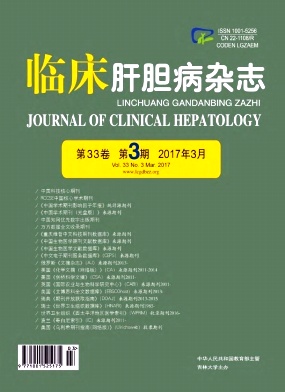|
[1]LALEMAN W, NEVENS F.Cirrhotic portal hypertension:current and future medical therapy for primary and secondary prevention of variceal bleeding[J].Minerva Medica, 2006, 97 (4) :325-345.
|
|
[2]TRIPATHI D, HAYES P C.The role of carvedilol in the management of portal hypertension[J].Eur J Gastroenterol Hepatol, 2010, 22 (8) :905-911.
|
|
[3]LIANG CL, FAN XM.Effects of carvedilol on hepatic fibrosis[J].Chin J Gen Prac, 2010, 8 (10) :1211-1212. (in Chinese) 梁春丽, 樊晓明.卡维地洛抗肝纤维化的试验研究[J].中华全科医学, 2010, 8 (10) :1211-1212.
|
|
[4]LIANG CL, FAN XM, BU SR.Effects of carvedilol on proliferation and apoptosis of hepatic stellate cells[J].Chin Hepatol, 2012, 17 (10) :709-711. (in Chinese) 梁春丽, 樊晓明, 卜淑蕊.卡维地洛对肝星状细胞增殖与凋亡的影响[J].肝脏, 2012, 17 (10) :709-711.
|
|
[5]JIAO J, FRIEDMAN SL, ALOMAN C.Hepatic fibrosis[J].Curr Opin Gastroenterol, 2009, 25 (3) :223-229.
|
|
[6]QU K, HUANG Z, LIN T, et al.New insight into the anti-liver fibrosis effect of multitargeted tyrosine kinase inhibitors:from molecular target to clinical trials[J].Front Pharmacol, 2016, 6:300.
|
|
[7]LIU XJ, YANG L, MAO YQ, et al.Effects of the tyrosine protein kinase inhibitor genistein on the proliferation, activation of cultured rat hepatic stellate cells[J].World J Gastroenterol, 2002, 8 (4) :739-745.
|
|
[8]YOSHIJI H, NOGUCHI R, KURIYAMA S, et al.Imatinib mesylate (STI-571) attenuates liver fibrosis development in rats[J].Am J Physiol Gastrointest Liver Physiol, 2005, 288 (5) :g907-g913.
|
|
[9]CHEN YX, LU CH, XIE WF, et al.Effects of ribozyme targeting platelet-derived growth factor receptor beta subunit gene on the proliferation and apoptosis of hepatic stellate cells in vitro[J].Chin Med J (Engl) , 2005, 118 (12) :982-988.
|
|
[10]IWAMOTO H, NAKAMUTA M, TADA S, et al.Platelet-derived growth factor receptor tyrosine kinase inhibitor AG1295 attenuates rat hepatic stellate cell growth[J].J Lab Clin Med, 2000, 135 (5) :406-412.
|
|
[11]BORKHAM-KAMPHORST E, STOLL D, GRESSNER AM, et al.Antisense strategy against PDGF B-chain proves effective in preventing experimental liver fibrogenesis[J].Biochem Biophys Res Commun, 2004, 321 (2) :413-423.
|
|
[12]HANADA M, FENG J, HEMMINGS BA.Structure, regulation and function of PKB/AKT-a major therapeutic target[J].Biochim Biophys Acta, 2004, 1697 (1-2) :3-16.
|
|
[13]FRIEDMAN S L.Mechanisms of hepatic fibrogenesis[J].Gastroenterology, 2008, 134 (6) :1655-1669.
|
|
[14]LEE YA, WALLACE MC, FRIEDMAN SL.Pathobiology of liver fibrosis:a translational success story[J].Gut, 2015, 64 (5) :830-841.
|
|
[15]ALTOMARE DA, TESTA JR.Perturbations of the AKT signaling pathway in human cancer[J].Oncogene, 2005, 24 (50) :7455-7464.
|
|
[16]WANG Y, GAO J, ZHANG D, et al.New insights into the antifibrotic effects of sorafenib on hepatic stellate cells and liver fibrosis[J].J Hepatol, 2010, 53 (1) :132-144.
|
|
[17]de FRANCHIS R, BAVENO VI FACULTY.Expanding consensus in portal hypertension:report of the Baveno VI Consensus Workshop:stratifying risk and individualizing care for portal hypertension[J].J Hepatol, 2015, 63 (3) :743-752.
|
|
[18]OBEN JA, YANG S, LIN H, et al.Norepinephrine and neuropeptide Y promote proliferation and collagen gene expression of hepatic myofibroblastic stellate cells[J].Biochem Biophys Res Commun, 2003, 302 (4) :685-690.
|
|
[19]KOBAYASHI N, NAKANO S, MORI Y, et al.Betaxolol inhibits extracellular signal-regulated kinase and P70S6 kinase activities and gene expressions of platelet-derived growth factor A-chain and transforming growth factor-beta1 in Dahl salt-sensitive hypertensive rats[J].Hypertens Res, 2002, 25 (2) :211-219.
|
|
[20]WONG VY, LAPING NJ, NELSON AH, et al.Renoprotective effects of carvedilol in hypertensive-stroke prone rats may involve inhibition of TGF beta expression[J].Br J Pharmacol, 2001, 134 (5) :977-984.
|
|
[21]LOTZE U, HEINKE S, FRITZENWANGER M, et al.Carvedilol inhibits platelet-derived growth factor-induced signal transduction in human cardiac fibroblasts[J].J Cardiovasc Pharmacol, 2002, 39 (4) :576-589.
|
|
[22]HAMDY N, EL-DEMERDASH E.New therapeutic aspect for carvedilol:antifibrotic effects of carvedilol in chronic carbon tetrachloride-induced liver damage[J].Toxicol Appl Pharmacol, 2012, 261 (3) :292-299.
|
|
[23]LIU J, TAKASE I, HAKUCHO A, et al.Carvedilol attenuates the progression of alcohol fatty liver disease in rats[J].Alcohol Clin Exp Res, 2012, 36 (9) :1587-1599.
|
|
[24]HAKUCHO A, LIU J, LIU X, et al.Carvedilol improves ethanolinduced liver injury via modifying the interaction between oxidative stress and sympathetic hyperactivity in rats[J].Hepatol Res, 2014, 44 (5) :560-570.
|









 本站查看
本站查看




 DownLoad:
DownLoad: